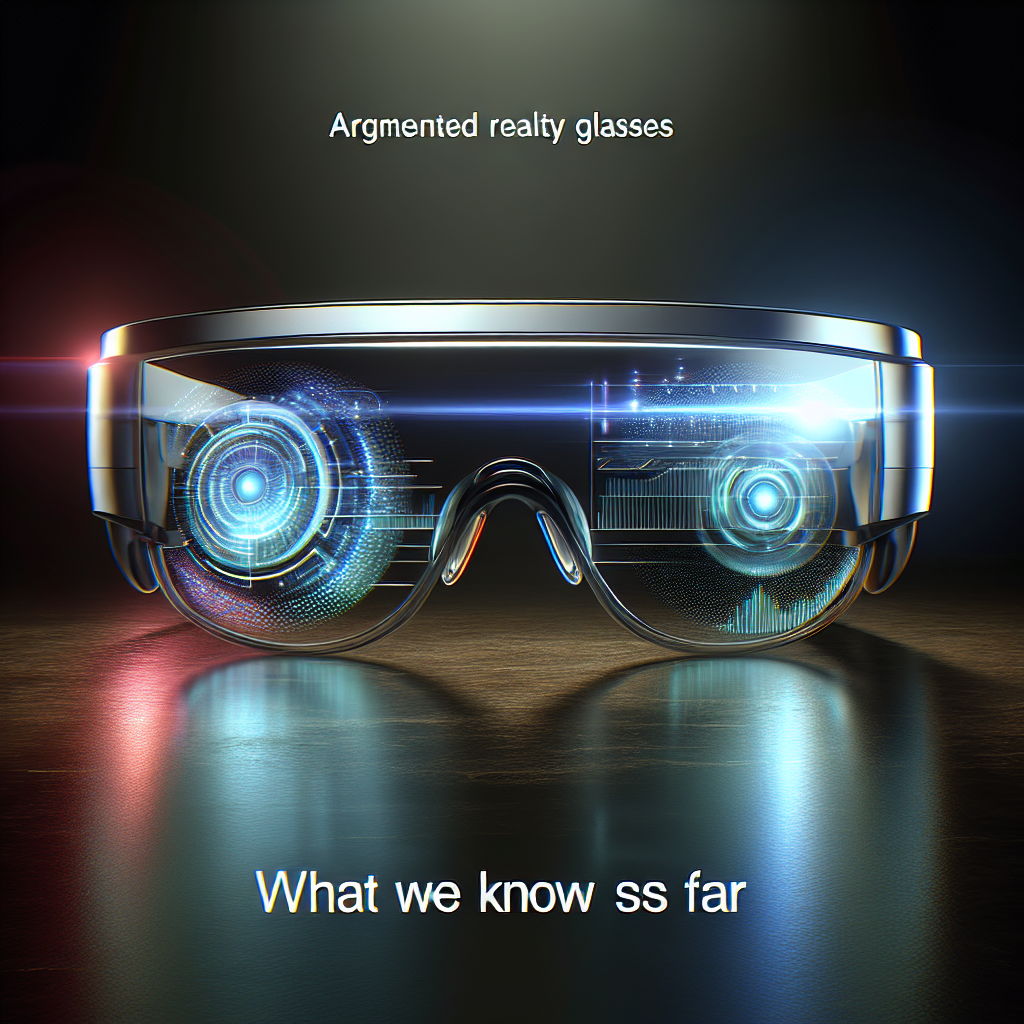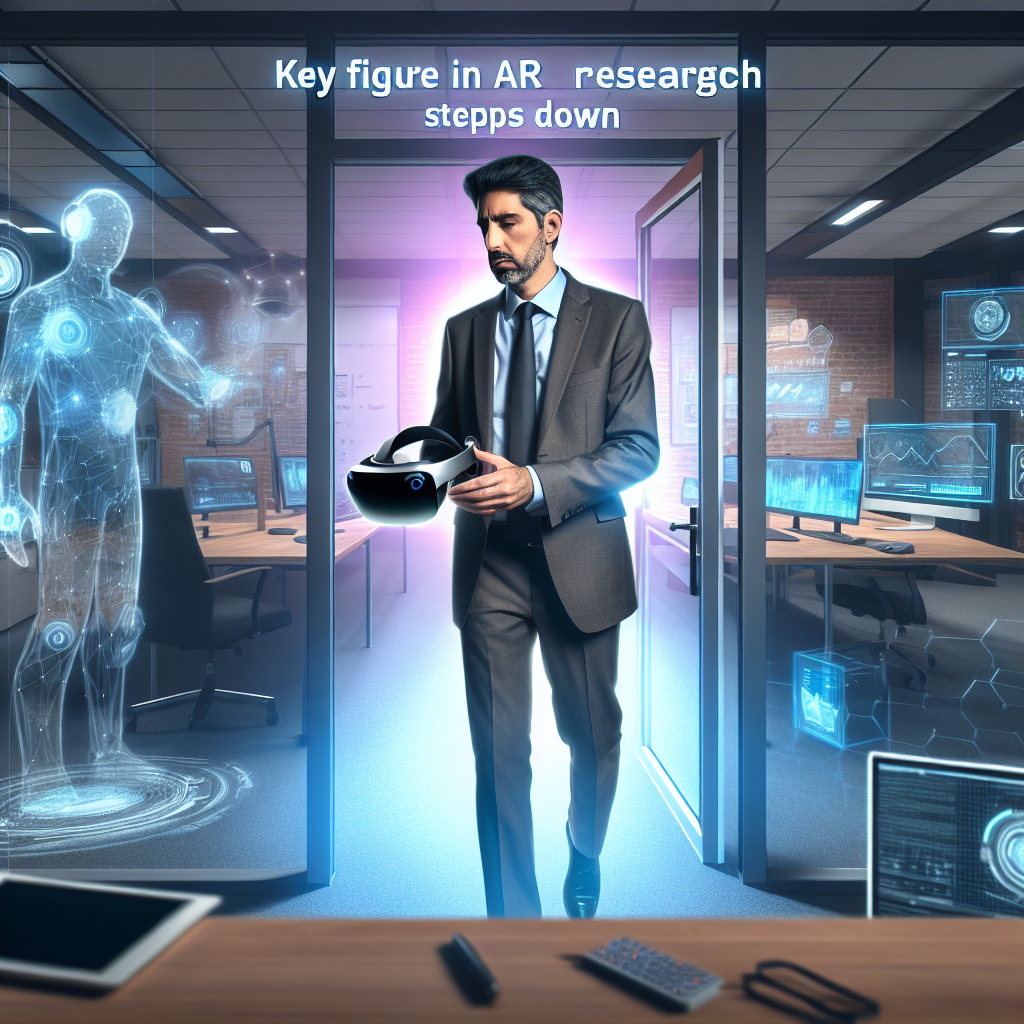Revolutionizing Reality: Unveiling the Exciting World of Meta AR Glasses
Meta AR Glasses have been making waves in the tech industry ever since their initial announcement. These futuristic glasses promise to revolutionize the way we interact with the world around us, merging the physical and digital realms seamlessly. With the potential to enhance our daily lives, Meta AR Glasses have generated a significant amount of excitement and anticipation. In this article, we will delve into what we know so far about these groundbreaking glasses, exploring their features, potential applications, and the challenges they may face.
First and foremost, Meta AR Glasses are designed to provide an augmented reality (AR) experience like no other. Unlike virtual reality (VR) headsets that completely immerse users in a digital environment, AR glasses overlay digital information onto the real world, allowing users to interact with both simultaneously. This means that with Meta AR Glasses, you can have a virtual screen floating in front of you while still being aware of your surroundings. This opens up a world of possibilities for gaming, productivity, education, and more. But what sets Meta AR Glasses apart from other AR devices is their advanced technology, including a wide field of view, high-resolution display, and sophisticated gesture recognition. These features aim to create a more immersive and intuitive AR experience, making the glasses feel like a natural extension of the user’s reality.
Key Takeaways
1. Meta AR Glasses are the next big leap in augmented reality technology, offering users an immersive and interactive experience.
2. The glasses are equipped with advanced sensors and cameras that enable precise tracking of the user’s surroundings, allowing for seamless integration of virtual objects into the real world.
3. Meta AR Glasses have a wide range of potential applications, from gaming and entertainment to education and professional training.
4. The glasses are expected to revolutionize the way we interact with digital content, providing a more natural and intuitive interface through gesture recognition and voice commands.
5. Despite the promising features, there are still challenges to overcome, such as the need for improved battery life and the potential privacy concerns associated with wearing a device that constantly captures and analyzes the user’s environment.
The Rise of Meta AR Glasses
Meta AR glasses, also known as augmented reality glasses, have been making waves in the tech industry in recent years. These glasses provide users with an immersive experience by overlaying virtual objects onto the real world. While the concept of AR glasses is not new, recent advancements in technology have made them more accessible and user-friendly. In this article, we will explore some emerging trends in the world of Meta AR glasses and their potential future implications.
1. Enhanced User Experience
One of the key trends in Meta AR glasses is the focus on enhancing the user experience. Early versions of AR glasses often suffered from limited field of view, bulky designs, and poor image quality. However, recent developments have addressed these issues, resulting in sleeker and more comfortable designs with improved optics.
Companies like Meta, Microsoft, and Magic Leap are investing heavily in research and development to create AR glasses that provide a seamless and immersive experience. These glasses are equipped with advanced sensors, cameras, and displays, allowing users to interact with virtual objects in a more natural and intuitive way. From gaming to productivity applications, the enhanced user experience offered by these glasses has the potential to revolutionize various industries.
2. Integration with Artificial Intelligence
Another emerging trend in Meta AR glasses is the integration of artificial intelligence (AI) capabilities. By combining AR with AI, these glasses can understand and interpret the user’s environment, making them more intelligent and context-aware.
For example, imagine wearing Meta AR glasses while shopping at a grocery store. The glasses could recognize the products on the shelves and provide real-time information such as prices, ingredients, and nutritional values. They could even suggest recipes based on the items in your cart. This integration of AI and AR has the potential to enhance our daily lives and make everyday tasks more efficient and convenient.
3. Collaboration and Communication
Meta AR glasses also have the potential to revolutionize collaboration and communication. With the rise of remote work and virtual meetings, there is a growing need for tools that enable seamless communication and collaboration across distances.
AR glasses can provide a virtual meeting space where participants can interact with each other and share information in real-time. They can overlay virtual objects onto the physical environment, allowing for a more immersive and engaging experience. This technology has the potential to transform industries such as architecture, engineering, and design by enabling remote teams to collaborate as if they were in the same room.
The Future of Meta AR Glasses
As Meta AR glasses continue to evolve, their future implications are vast and exciting. Here are some potential highlights:
1. Integration with Internet of Things (IoT)
Meta AR glasses have the potential to become a central hub for interacting with the Internet of Things (IoT). By connecting to various smart devices and sensors, these glasses can provide users with real-time information and control over their surroundings.
Imagine wearing AR glasses that can display information about the temperature, air quality, or energy consumption of a room. They could also provide notifications and alerts from connected devices such as smart home security systems or wearable health trackers. This integration with IoT has the potential to create a truly connected and intelligent ecosystem.
2. Personalized and Adaptive Experiences
With advancements in AI and machine learning, Meta AR glasses have the potential to offer personalized and adaptive experiences. These glasses can learn from the user’s preferences, behavior, and environment to provide tailored recommendations and information.
For example, if a user frequently visits art museums, their AR glasses could provide detailed information about the artwork they are viewing, offer suggestions for similar artists or genres, and even provide interactive experiences like virtual tours or augmented reality storytelling. This level of personalization and adaptability has the potential to enhance our daily lives and enrich our experiences in various domains.
3. Augmented Reality as a Platform
As Meta AR glasses become more mainstream, there is a possibility that augmented reality could evolve into a platform of its own. Just as smartphones have become a central hub for various applications and services, AR glasses could become the primary interface for accessing digital content and services.
Imagine a future where you can order food, book a ride, or watch a movie, all through your AR glasses. This platformization of augmented reality has the potential to disrupt traditional industries and create new opportunities for developers and businesses.
Insight 1: Meta AR Glasses are set to revolutionize the way we interact with technology
The advent of augmented reality (AR) has already had a significant impact on various industries, from gaming to healthcare. However, the of Meta AR Glasses promises to take this technology to a whole new level. These glasses, developed by Meta, a leading AR company, have the potential to revolutionize the way we interact with technology in our daily lives.
One of the key features of Meta AR Glasses is their ability to overlay digital information onto the real world, creating a seamless blend of the physical and virtual realms. This opens up a world of possibilities in terms of productivity, entertainment, and communication. For example, imagine being able to view and interact with digital objects and information in your immediate environment, without the need for a separate screen or device. Whether it’s checking your emails, browsing the internet, or playing games, Meta AR Glasses have the potential to transform these experiences into something truly immersive and interactive.
Moreover, Meta AR Glasses offer a hands-free experience, allowing users to interact with the digital world using natural gestures and voice commands. This eliminates the need for traditional input devices such as keyboards or controllers, making the overall experience more intuitive and user-friendly. This hands-free approach also has significant implications for industries such as manufacturing, where workers can access important information and instructions without having to pause their tasks or use their hands to operate a device.
Insight 2: Meta AR Glasses have the potential to disrupt multiple industries
With their unique capabilities, Meta AR Glasses have the potential to disrupt multiple industries, transforming the way we work, learn, and entertain ourselves.
In the field of healthcare, for instance, Meta AR Glasses can enhance the precision and efficiency of medical procedures. Surgeons can overlay vital patient information, such as medical records or real-time imaging, directly onto their field of view, allowing for more accurate diagnoses and better-informed decisions. Additionally, these glasses can assist in training healthcare professionals by providing virtual simulations and step-by-step guidance, improving the learning experience and reducing the risks associated with real-life practice.
Another industry that can benefit greatly from Meta AR Glasses is education. These glasses can bring learning to life by overlaying interactive 3D models, historical reenactments, or virtual field trips onto the real-world environment. Students can explore complex concepts in a more engaging and immersive manner, making education more effective and enjoyable. Furthermore, Meta AR Glasses can facilitate remote learning, allowing students and teachers to connect and collaborate regardless of their physical location.
From a business perspective, Meta AR Glasses can revolutionize the way we collaborate and communicate. With the ability to overlay virtual objects and information onto the real world, these glasses can transform traditional meetings and presentations into interactive and dynamic experiences. Team members can visualize and manipulate data in real-time, improving decision-making and fostering creativity. Moreover, Meta AR Glasses can enable remote collaboration, allowing teams to work together seamlessly, regardless of their geographical location.
Insight 3: Challenges and considerations for the widespread adoption of Meta AR Glasses
While the potential of Meta AR Glasses is undeniable, there are several challenges and considerations that need to be addressed for their widespread adoption.
Firstly, the issue of privacy and security arises with the use of Meta AR Glasses. These glasses have the ability to capture and store vast amounts of data about the user’s surroundings, which raises concerns about the potential misuse or unauthorized access to this information. Striking a balance between the benefits of AR technology and the protection of personal privacy will be crucial for its acceptance and adoption.
Secondly, the current limitations of AR technology, such as the field of view and resolution, need to be overcome for Meta AR Glasses to deliver a truly immersive and seamless experience. Users may find it disorienting or distracting if the digital overlays are not aligned properly with the real world or if the resolution is not high enough to render realistic and detailed graphics. Continuous advancements in hardware and software will be necessary to address these challenges.
Lastly, the cost of Meta AR Glasses may pose a barrier to widespread adoption. As with any emerging technology, the initial cost is often high, making it inaccessible to a large portion of the population. However, as the technology matures and economies of scale come into play, it is expected that the cost of Meta AR Glasses will decrease, making them more affordable and accessible to a wider audience.
Section 1: The Evolution of AR Glasses
AR glasses have come a long way since their inception. The early prototypes were bulky, heavy, and had limited functionality. However, with advancements in technology, we are now witnessing the rise of Meta AR Glasses, which promise to revolutionize the way we interact with the digital world. These glasses combine the power of augmented reality with sleek, lightweight designs, making them more accessible and user-friendly than ever before.
Section 2: Key Features and Functionality
Meta AR Glasses are packed with innovative features that enhance the user experience. One of the standout features is the ability to overlay digital information onto the real world seamlessly. This means users can see virtual objects, text, and images superimposed onto their surroundings, providing a truly immersive augmented reality experience. Additionally, these glasses often include built-in cameras, sensors, and voice recognition technology, enabling users to interact with the virtual content in a natural and intuitive way.
Section 3: Applications in Various Industries
The potential applications of Meta AR Glasses span across a wide range of industries. In the healthcare sector, these glasses can assist surgeons during complex procedures by displaying vital patient information in real-time. They can also be used for training purposes, allowing medical students to practice procedures in a simulated environment. In the retail industry, AR glasses can provide customers with virtual try-on experiences, allowing them to see how clothing or accessories would look on them without physically trying them on. The possibilities are endless, and we are only scratching the surface of what these glasses can do.
Section 4: Challenges and Limitations
Despite their potential, Meta AR Glasses still face some challenges and limitations. One of the main concerns is the issue of privacy. As these glasses have built-in cameras and sensors, there is a risk of unauthorized recording or tracking of individuals. Another challenge is the limited field of view, which can hinder the immersive experience. Additionally, the high cost of these glasses may limit their adoption, especially in consumer markets. However, as technology continues to advance, we can expect these challenges to be addressed and overcome in the future.
Section 5: Case Study: Meta AR Glasses in Education
One area where Meta AR Glasses have shown great promise is in the field of education. A case study conducted at a high school in California demonstrated how these glasses can enhance the learning experience. Students were able to visualize complex scientific concepts in 3D, making abstract ideas more tangible and easier to understand. The glasses also allowed for collaborative learning, as students could share their virtual creations with their peers. This case study highlights the potential of Meta AR Glasses to revolutionize education and make learning more engaging and interactive.
Section 6: The Future of Meta AR Glasses
The future of Meta AR Glasses looks bright. As technology continues to advance, we can expect these glasses to become even more lightweight, affordable, and feature-rich. The integration of artificial intelligence and machine learning algorithms will further enhance the capabilities of these glasses, making them smarter and more intuitive. We can also anticipate the development of a robust ecosystem of AR applications and content specifically designed for Meta AR Glasses, further expanding their potential uses and benefits.
Section 7: The Impact on Society and Everyday Life
Meta AR Glasses have the potential to transform society and everyday life in numerous ways. From revolutionizing how we work and learn to changing how we shop and entertain ourselves, these glasses can seamlessly blend the digital and physical worlds. Imagine walking down the street and instantly receiving information about nearby restaurants, shops, or historical landmarks. Or envision a world where remote collaboration becomes effortless, with colleagues appearing as holograms in your living room. The impact of Meta AR Glasses on society will be profound, reshaping our interactions and experiences.
Section 8: Competitors and Market Landscape
Meta AR Glasses are not the only players in the augmented reality glasses market. Competitors such as Microsoft HoloLens and Magic Leap are also vying for dominance in this space. Each of these glasses offers unique features and capabilities, catering to different use cases and industries. The market for AR glasses is still relatively nascent, but it is expected to grow rapidly in the coming years as more companies and individuals recognize the potential of augmented reality.
Section 9: User Feedback and Adoption
Early adopters of Meta AR Glasses have provided valuable feedback on their experiences. Overall, users have praised the immersive nature of the augmented reality experience and the potential for these glasses to enhance productivity and creativity. However, some have expressed concerns about the comfort and aesthetics of the glasses, suggesting that further improvements are needed in these areas to encourage wider adoption. As more people get their hands on these glasses and provide feedback, we can expect iterative improvements and refinements to address these concerns.
Meta AR Glasses represent the next frontier in augmented reality technology. With their sleek designs, advanced features, and potential applications across various industries, these glasses have the power to reshape the way we interact with the digital world. While challenges and limitations still exist, the future looks promising for Meta AR Glasses as technology continues to advance and user feedback drives iterative improvements. As we eagerly await their widespread availability, it’s clear that the world of augmented reality is about to take a giant leap forward.
Display Technology
The Meta AR glasses are equipped with advanced display technology that allows users to see virtual objects overlaid onto the real world. The glasses use a combination of waveguide optics and holographic displays to achieve this augmented reality experience.
Waveguide optics work by guiding light waves through a thin, transparent substrate, which is coated with special materials that reflect and refract light in specific ways. This allows the glasses to project virtual images onto the user’s field of view without obstructing their vision of the real world.
The holographic displays used in the Meta AR glasses create 3D virtual objects that appear to be floating in space. These displays use a combination of lasers, mirrors, and diffraction gratings to create interference patterns that generate the illusion of depth and realism.
Sensor Technology
The Meta AR glasses are equipped with an array of sensors that enable precise tracking of the user’s movements and the surrounding environment. These sensors include accelerometers, gyroscopes, magnetometers, and depth sensors.
Accelerometers measure the linear acceleration of the glasses, allowing them to detect movements such as walking, running, or shaking. Gyroscopes measure the angular velocity, enabling the glasses to track rotational movements and changes in orientation.
Magnetometers detect changes in the magnetic field, which can be used to determine the glasses’ orientation relative to the Earth’s magnetic field. This helps in providing accurate spatial tracking and alignment of virtual objects with the real world.
Depth sensors, such as time-of-flight cameras or structured light systems, measure the distance between the glasses and objects in the environment. This enables the glasses to accurately place virtual objects in the user’s field of view, creating a seamless augmented reality experience.
Processing Power
The Meta AR glasses are powered by a high-performance processor that handles the complex computations required for rendering virtual objects and tracking the user’s movements in real-time. The exact specifications of the processor have not been disclosed, but it is expected to be a powerful system-on-chip (SoC) specifically designed for augmented reality applications.
The processor is responsible for running the operating system and software applications that enable the glasses to interact with the user and the environment. It also handles the processing of sensor data, image recognition, and spatial mapping algorithms to create a smooth and responsive augmented reality experience.
Connectivity
The Meta AR glasses support wireless connectivity, allowing them to communicate with other devices and access online services. They are expected to have built-in Wi-Fi and Bluetooth capabilities, enabling seamless integration with smartphones, tablets, and other compatible devices.
Wireless connectivity enables the glasses to stream data, such as real-time video feeds or information from cloud-based services, directly to the user’s field of view. It also enables the glasses to receive updates and software upgrades, ensuring that users have access to the latest features and improvements.
User Interface
The user interface of the Meta AR glasses is designed to be intuitive and easy to use. It relies on a combination of voice commands, gestures, and eye tracking to interact with virtual objects and control the glasses’ features.
Voice commands allow users to perform actions or access information without the need for physical input. The glasses are equipped with built-in microphones and advanced speech recognition algorithms that can accurately interpret and respond to natural language commands.
Gestures, such as swiping or tapping in the air, can be used to manipulate virtual objects or navigate through menus and options. The glasses use computer vision algorithms to track the user’s hand movements and interpret them as input commands.
Eye tracking technology is also incorporated into the glasses, allowing them to detect the user’s gaze and focus. This enables a more natural and immersive interaction with virtual objects, as they can respond to the user’s eye movements and adjust their behavior accordingly.
FAQs
1. What are Meta AR Glasses?
Meta AR Glasses are augmented reality (AR) glasses developed by Meta Company. They are designed to overlay digital information and virtual objects onto the real world, enhancing the user’s perception and interaction with their surroundings.
2. How do Meta AR Glasses work?
Meta AR Glasses use a combination of cameras, sensors, and displays to create an augmented reality experience. The cameras capture the real-world environment, while the sensors track the user’s movements and position. The glasses then project digital images onto the lenses, aligning them with the user’s perspective.
3. What can you do with Meta AR Glasses?
Meta AR Glasses offer a wide range of possibilities. Users can access information, navigate through virtual interfaces, play games, create 3D models, and collaborate with others in augmented reality. The glasses can also be used for productivity, such as displaying notifications, reminders, and virtual screens for multitasking.
4. Are Meta AR Glasses wireless?
Yes, Meta AR Glasses are designed to be wireless. They connect to other devices, such as smartphones or computers, using wireless technologies like Bluetooth or Wi-Fi. This allows for a more seamless and untethered AR experience.
5. Can Meta AR Glasses be used outdoors?
Yes, Meta AR Glasses can be used both indoors and outdoors. The glasses are equipped with sensors and cameras that adapt to different lighting conditions, ensuring a consistent AR experience regardless of the environment.
6. How comfortable are Meta AR Glasses to wear?
Meta AR Glasses are designed with comfort in mind. The glasses are lightweight and have adjustable frames to fit different head sizes. The lenses are also made to be transparent, allowing users to see their surroundings without obstruction.
7. Can Meta AR Glasses be used by people with prescription glasses?
Yes, Meta AR Glasses can be worn over prescription glasses. The glasses have enough space to accommodate most prescription eyewear, allowing users to enjoy the augmented reality experience without the need to remove their regular glasses.
8. How long does the battery last on Meta AR Glasses?
The battery life of Meta AR Glasses can vary depending on usage. However, Meta Company claims that the glasses can last for several hours on a single charge. The glasses also come with a charging case for convenient recharging on the go.
9. Are Meta AR Glasses compatible with all devices?
Meta AR Glasses are designed to be compatible with a wide range of devices, including smartphones, tablets, and computers. They can connect to these devices wirelessly or through wired connections, depending on the user’s preference and the specific use case.
10. When will Meta AR Glasses be available to the public?
As of now, Meta AR Glasses are not yet available to the public. The glasses are still in development, and Meta Company has not announced an official release date. However, they have conducted demonstrations and trials with select partners and developers, indicating that a public release may be on the horizon.
1. Stay Informed and Research
With the rapid advancements in technology, it’s important to stay informed about the latest developments in the field of augmented reality (AR) glasses. Follow reputable tech websites, subscribe to newsletters, and join online communities or forums to keep up-to-date with the latest news, reviews, and discussions about AR glasses. This will help you make informed decisions when considering purchasing or using these devices.
2. Understand the Features and Limitations
Take the time to understand the features and limitations of the specific AR glasses you are interested in. Each device may have different capabilities, such as displaying virtual information, providing real-time navigation, or enhancing gaming experiences. Understanding these features will help you make the most of the device and manage your expectations.
3. Explore Different Use Cases
AR glasses offer a wide range of potential applications beyond gaming and entertainment. Explore different use cases to discover how these devices can enhance your daily life. From productivity tools for work, interactive learning experiences, to immersive travel guides, AR glasses have the potential to revolutionize various aspects of our lives. Experiment with different apps and experiences to find what works best for you.
4. Prioritize Privacy and Security
AR glasses have the potential to collect and process a significant amount of personal data. Prioritize privacy and security when using these devices. Understand the data collection practices of the apps and services you use with AR glasses, and ensure they align with your privacy preferences. Be mindful of sharing sensitive information or granting unnecessary permissions to apps.
5. Customize and Personalize
Most AR glasses offer customization options to tailor the device to your preferences. Take advantage of these features to make the device more comfortable and suited to your needs. Adjust the fit, brightness, and display settings to optimize your experience. Additionally, explore different apps and interfaces to personalize the device according to your preferences.
6. Manage Battery Life
AR glasses rely on battery power to function. To make the most of your device, manage its battery life effectively. Close unnecessary apps, reduce screen brightness, and disable features that are not in use. Carry a portable charger or power bank when using AR glasses on the go to ensure you don’t run out of power when you need it most.
7. Practice Digital Etiquette
When wearing AR glasses in public, be mindful of others around you. Practice good digital etiquette by not invading people’s privacy, respecting personal boundaries, and avoiding excessive use of AR features in public spaces. Use AR glasses responsibly and considerate of the social norms and expectations of the environment you are in.
8. Take Breaks and Be Mindful of Health
Extended use of AR glasses can strain your eyes and lead to discomfort. Take regular breaks to rest your eyes and avoid prolonged use without breaks. Additionally, be mindful of your posture and neck position while using AR glasses to prevent any physical discomfort or strain. If you experience any discomfort, consult a healthcare professional.
9. Collaborate and Share Experiences
Connect with others who use AR glasses to collaborate, share experiences, and learn from each other. Join online communities, attend meetups or conferences, and engage in discussions about AR glasses. By sharing knowledge and experiences, you can discover new apps, tips, and tricks that enhance your daily life with AR glasses.
10. Embrace the Learning Curve
AR glasses are still relatively new technology, and using them may require a learning curve. Embrace the learning process and be patient with yourself. Take the time to explore the features, experiment with different apps, and adapt to the new ways of interacting with the digital world. With time and practice, you will become more proficient and comfortable with using AR glasses in your daily life.
In conclusion, Meta AR Glasses have the potential to revolutionize the way we interact with the world around us. These glasses offer a wide range of features and capabilities, from augmented reality overlays to immersive gaming experiences. The article explored the key aspects of Meta AR Glasses, including their design, functionality, and potential applications.
We learned that Meta AR Glasses are lightweight and sleek, making them comfortable to wear for extended periods. They utilize advanced sensors and cameras to track the user’s movements and environment, providing a seamless augmented reality experience. The glasses can overlay digital information onto the real world, allowing users to access information, play games, and even communicate with others in entirely new ways.
Additionally, the article discussed the potential applications of Meta AR Glasses across various industries, such as healthcare, education, and entertainment. These glasses could be used in medical training to simulate surgeries, in classrooms to enhance learning experiences, and in gaming to create immersive virtual worlds. The possibilities are vast, and it is exciting to imagine how Meta AR Glasses could shape the future.
Overall, Meta AR Glasses hold tremendous promise for the future of augmented reality. As technology continues to advance, we can expect to see even more innovative features and applications for these glasses. Whether it’s improving productivity, enhancing entertainment experiences, or transforming industries, Meta AR Glasses have the potential to change the way we perceive and interact with the world around us.




